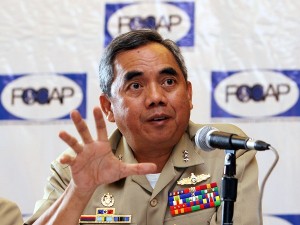Philippines, Vietnam try football diplomacy in Spratlys

Philippine Navy Flag Officer in Command Vice Admiral Alexander Pama announces that the Philippine and Vietnamese navies have agreed to let their sailors play football and basketball on the disputed Spratly Islands to ease tension and build trust. AP
MANILA, Philippines—Philippine and Vietnamese sailors will play football and basketball matches on disputed West Philippine Sea (South China Sea) islands in a novel way to build trust in a region long feared as Asia’s next flashpoint for armed conflict.
The navies of the two countries have reached an agreement to conduct the “fun games” on two islands occupied by the Philippines and Vietnam, Philippine Navy chief Vice Admiral Alexander Pama said Tuesday.
He said the games were part of a broader agreement he signed in October with his Vietnamese counterpart. While the games are unlikely to make much difference on the ground, the rest of the agreement calls for their navies to undertake confidence-building steps and share more information to allow them to better respond to maritime accidents in the disputed Spratly Islands.
China, which claims virtually the entire West Philippine Sea, is likely to protest such a show of military alliance in the disputed region. The Chinese Embassy in Manila did not immediately respond to an Associated Press request for comment.
Last year, the Philippines and Vietnam separately accused Chinese vessels of intruding into their territorial waters and disrupting oil explorations. China has dismissed the protests, saying Beijing has indisputable sovereignty over those areas on historical grounds.
Article continues after this advertisementThe three Asian nations, along with Brunei, Malaysia and Taiwan, have been locked in a long-simmering rift over West Philippine Sea territories, including the Spratlys — a chain of islands, reefs and coral outcrops believed to be lying atop vast undersea deposits of oil and gas. The Spratly Islands also straddle one of the world’s busiest commercial sealanes.
Article continues after this advertisementFaced with China’s formidable military, the Philippines and Vietnam have forged closer ties amid the territorial disputes. Aside from the navy-to-navy accord, the two countries agreed to set up a hotline between their coast guards and maritime police to strengthen their capability to monitor “maritime incidents,” such as piracy, and incursions into their territorial waters.
Under the naval agreement, Pama said Filipino navy men could visit the main Spratly island occupied by their Vietnamese counterparts and vice versa, then play football and basketball, although no date has been set for the friendly games. They can exchange information on a variety of issues and plan how best to respond to accidents such as those involving fishermen, he said.
Mayor Eugenio Bito-onon Jr., who heads a small civilian community on Pag-asa, a Spratly island occupied by Philippine forces, welcomed the warming ties between the Filipinos and the Vietnamese. Vietnamese troops occupy Southwest Cay island several kilometers from Pag-asa island.
“This will lessen the tension and apprehension about a shooting war,” Bito-onon told The AP by telephone. “It’s good if they’ll play games, eat on the same table … than not have a line of communication.”
Despite such diplomacy, the underfunded Philippine military has struggled to build up its capability to patrol and defend its territorial waters, Pama said, adding that the average age of some of the local navy’s ships was 57 years. “Our ships are older than me,” he said.
The United States, a defense-treaty ally, last year provided a refurbished Coast Guard cutter, which was turned into the Philippine navy’s largest and most-modern warship, and would turn over a second such ship next month, Pama said.
The battle over the resource-rich Spratlys has settled into an uneasy standoff since the last fighting, involving China and Vietnam, that killed more than 70 Vietnamese sailors in 1988.
For comprehensive coverage, in-depth analysis, visit our special page for West Philippine Sea updates. Stay informed with articles, videos, and expert opinions.